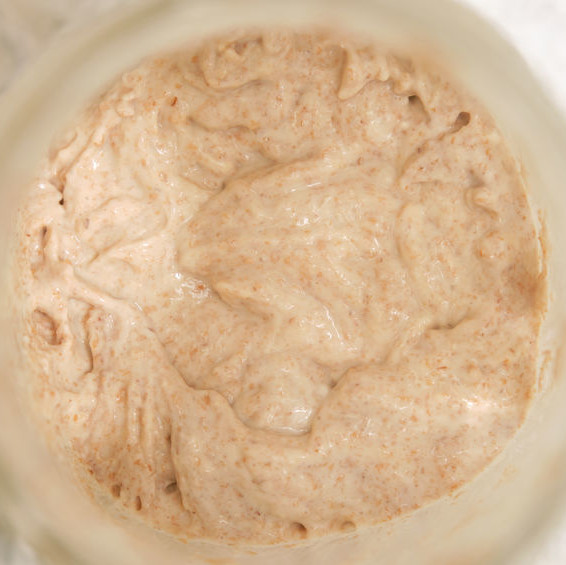
Poolish
Also known as Pâte fermentée, liquid pre-ferment or liquid sponge
What is Poolish?
Poolish is a highly fluid yeast-cultured dough. It’s a type of pre-ferment traditionally used in the production of French bakery products.
A Poolish resembles a sponge for the sponge and dough system. The difference is Poolish is fermented much longer and uses a much higher hydration than a plastic sponge—which is why it’s considered the liquid version of a sponge.1 Typical hydration levels are 100%, with equal weights of flour and water.
Origin
This breadmaking method was first developed in Poland during the 1840s by a nobleman named Baron Zang. Poolish was later spread by Viennese bakers into Austria who upon emigrating to France around 1840 initiated the production of Vienna breads and other luxury bakery products in Paris using the Poolish technique. With this technique bakers switched from using associations of yeast and sourdough (sur levain in French) to yeast alone for carrying out fermentation at the bakeshop.2,3
How does a Poolish work?
A Poolish combines equal parts flour and water (by weight) with some yeast (the amount varies according to the expected length of fermentation time, using less for longer, slower fermentations).
The fermentation is then carried out at room temperature for periods of time long enough to bubble up and increase its volume. At its peak, the volume starts to fall back slightly (recede) with the appearance of a wrinkled surface. This process can take anywhere from 3 to 15 hours, depending on the inoculation level.4,2
| Compressed yeast inoculation (baker’s %)5 | Fermentation time (hours)* |
| 3 | 1–2 |
| 1.5 | 3–4 |
| 0.8 | 7–8 |
| 0.25 | 12–15 |
* Considering a dough temperature of 26–29°C (79–84°F) and 100% hydration.
The rate of fermentation is governed by the following factors:
- Mixture acidity
- Temperature
- Available food supply
- Water content
Poolish Formula5
Ingredients:
- Flour
- Water (100%)
- Fresh or compressed yeast (0.1–1.5%)
| Ingredient | Baker’s percent |
| Sponge (Poolish)* | |
| Bread flour | 30.0 |
| Water | 30.0 (100% hydration) |
| Yeast, instant | 0.7 |
| Dough | |
| Bread flour | 70.0 (to complete 100%) |
| Water | 37.0 (53% hydration) |
| Salt | 1.75 |
| Malt syrup | 1.0 |
*The Poolish can be used at up to 60% of the total weight of final developed dough.
Process:
- Scaling/metering of ingredients
- Mixing to incorporate ingredients at low speed (1–2 minutes at 26°C or 79°F)
- Transfer to the fermentation room or trough
- Fermentation
Application
A Poolish is used as a sponge in the production of French bread, baguettes and batards. The advantages and disadvantages are:
| Advantages6 |
|
| Disadvantages |
|
If a poolish is used on a daily basis, then the bakery needs space for fermentation as well as containers or troughs (in sufficient number and size, and proper hygienic design) for the preparation of the pre-ferments.7
A Poolish should not be allowed to ferment for excessive periods of time to avoid gluten breakdown as well as increasing acidity and alcohol content to unacceptable levels.
References
- Moore, T.R. “Breads” Encyclopedia of Food Grains, 2nd ed., vol. 3, Elsevier Ltd., 2016, pp. 8–12.
- Pagani, M.A. “Technology of Baked Goods” Handbook of Sourdough Biotechnology, first printing, Springer Science+Business Media New York, 2013 p. 60.
- Wirtz, R.L. “Grain, Baking, and Sourdough Bread: A Brief Historical Panorama” Handbook of Dough Fermentations, first printing, Marcel Dekker, Inc., 2003, pp. 27–28.
- The Culinary Institute of America. “Advanced Yeast Breads and Rolls” Baking and Pastry: Mastering the Art and Craft, 2nd edition, John Wiley & Sons, Inc., Hoboken, New Jersey, 2016, pp. 147–184.
- Gisslen, W. “Lean Yeast Doughs: Sponges, Pre-ferments, and Sourdoughs” Professional Baking, 7th edition, John Wiley & Sons, Inc., Hoboken, New Jersey, 2017, pp. 155–179.
- Figoni P. “Gluten” How Baking Works, 3rd edition, John Wiley & Sons, Inc., Hoboken, New Jersey, 2011, pp. 147–149.
- O’Donnell, K. “Equipment” Bakery Production Handbook, first printing, Xlibris Publishing, 2016, pp. 253–255.

